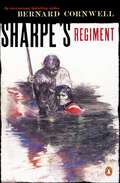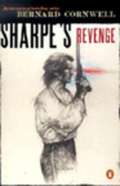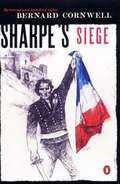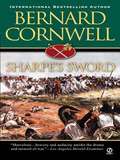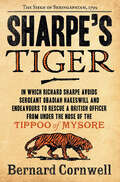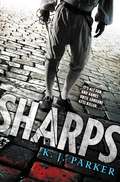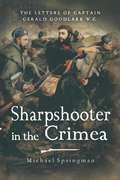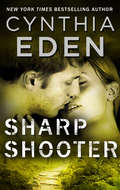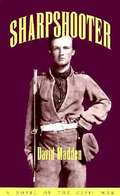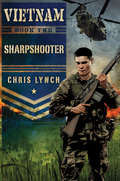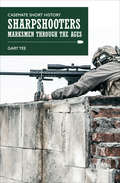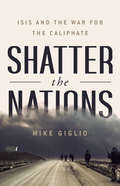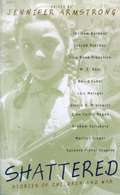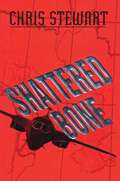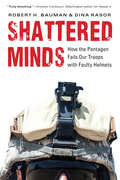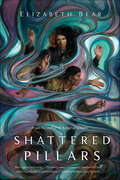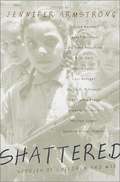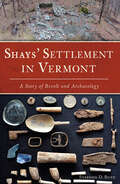- Table View
- List View
Sharpe's Regiment (#8): Richard Sharpe And The Invasion Of France, June To November 1913
by Bernard Cornwell"Apart from the rousing battle scenes, the author is as his best in evoking a long-gone era through clever detail."--The New York Times Book Review A corrupt political enemy is determined to disband the South Essex Regiment -- and to destroy Major Richard Sharpe. Sharpe returns to England and discovers an illegal recruiting ring that sells soldiers like cattle to other divisions. The ringleaders know Sharpe is on their trail, and they try to kill him at every turn. But Sharpe is fighting for his command, and as he moves from the dark slums of London to the highest courts of political power, Sharpe will risk charges of treason and death for a final chance at revenge. "A ripping yarn."--The Washington Post "Consistently exciting . . . these are wonderful novels."--Stephen King
Sharpe's Revenge: Richard Sharpe and the Peace of 1814 (Richard Sharpe #21)
by Bernard CornwellWhen his honor and reputation are at stake, Sharpe seeks revenge--at any cost It is 1814, and the defeat of Napoleon seems imminent--if the well-protected city of Toulouse can be conquered. For Richard Sharpe, the battle turns out to be one of the bloodiest of the Peninsula Wars, and he must draw on his last reserves of strength to lead his troops to victory. But before Sharpe can lay down his sword, he must fight a different sort of battle. Accused of stealing Napoleon's personal treasure, Sharpe escapes from a British military court and embarks on the battle of his life--armed only with the unflinching resolve to protect his honor.
Sharpe's Rifles
by Bernard CornwellBernard Cornwell's action-packed series that captures the gritty texture of Napoleonic warfare--now beautifully repackagedIt's 1809, and Napoleon's army is sweeping across Spain. Lieutenant Richard Sharpe is newly in command of the demoralized, distrustful men of the 95th Rifles. He must lead them to safety--and the only way of escape is a treacherous trek through the enemy-infested mountains of Spain.
Sharpe's Siege
by Bernard CornwellSharpe's mission has seemed simple: capture a small unguarded French coastal fort, cripple Napoleon's supply lines, and retreat across the sea. But behind the lines, Sharpe's old enemy, Pierre Ducos, awaits Sharpe's arrival with a battalion of French soldiers and a vicious commanding general who keeps the scalps of his dead enemies as trophies.
Sharpe's Sword: Richard Sharpe And The Salamanca Campaign, June And July 1812 (Richard Sharpe Adventure Ser. #No. 14)
by Bernard CornwellThe greatest threat to Wellington's Salamanca Campaign is not Napoleon's Army but France's deadliest assassin. He's already failed to kill Captain Richard Sharpe once. Now, he's getting a second chance.
Sharpe's Tiger: The Siege of Seringapatam, 1799 (Sharpe #1)
by Bernard CornwellFrom New York Times bestselling author Bernard Cornwell, the first exciting adventure in the world-renowned Sharpe series, chronicling the rise of Richard Sharpe, a Private in His Majesty’s Army at the siege of Seringapatam. “The greatest writer of historical adventures today.” —Washington PostRichard Sharpe. Soldier, hero, rogue—the man you always want on your side. Born in poverty, he joined the army to escape jail and climbed the ranks by sheer brutal courage. He knows no other family than the regiment of the 95th Rifles, whose green jacket he proudly wears.
Sharpe's Trafalgar: Richard Sharpe and the Battle of Trafalgar, October 21, 1805 (Sharpe #4)
by Bernard Cornwell"The greatest writer of historical adventures today." —Washington PostCritically acclaimed, perennial New York Times bestselling author Bernard Cornwell (Agincourt, The Fort, the Saxon Tales) makes real history come alive in his breathtaking historical fiction. Praised as "the direct heir to Patrick O'Brian" (Agincourt, The Fort), Cornwell has brilliantly captured the fury, chaos, and excitement of battle as few writers have ever done—perhaps most vividly in his phenomenally popular novels following the illustrious military career of British Army officer Richard Sharpe during the late 18th and early 19th centuries. Chronicling Sharpe's involvement in the famous Battle of Trafalgar in 1805, Sharpe's Trafalgar finds the young ensign captive on a French warship and in gravest peril on the eve of the one of the most spectacular naval confrontations in history. Perhaps the San Francisco Chronicle said it best: "If only all history lessons could be as vibrant."
Sharpe's Triumph: Richard Sharpe and the Battle of Assaye, September 1803 (Sharpe #2)
by Bernard CornwellFrom New York Times bestselling author Bernard Cornwell, the second installment in the world-renowned Sharpe series, chronicling the rise of Richard Sharpe, a Private in His Majesty’s Army at the siege of Seringapatam."The greatest writer of historical adventures today." —Washington PostRichard Sharpe. Soldier, hero, rogue—the man you always want on your side. Born in poverty, he joined the army to escape jail and climbed the ranks by sheer brutal courage. He knows no other family than the regiment of the 95th Rifles, whose green jacket he proudly wears.
Sharpe's Waterloo: Richard Sharpe and the Waterloo Campaign (Richard Sharpe's Adventure Series #20)
by Bernard CornwellThe British and their allies are preparing for a grand society ball in Brussels. Amongst the names on the glittering guest-list is a very reluctant newly promoted Lieutenant Colonel Richard Sharpe. Sharpe finds himself on the personal staff of the Young Frog, Frederick, Prince of Orange, who, at a tender age and with no experience whatsoever, has been given command of a large proportion of the Allied Forces. More concerned with cutting a dash at the ball, the Young Frog refuses to listen to Sharpe's scouting reports of an enormous French army marching towards Brussels with the lately returned Emperor Napoleon at its head-- until it is nearly too late. In the middle of the festivities Sharpe bursts in with the news that the British-Prussian link is under attack-- and in the scramble that ensues, as officers are ordered to rejoin their regiments, he comes face-to-face with his estranged wife, Jane, and her lover, Lord John Rossendale, on whom he has sworn revenge. The British counter Napoleon's cavalry at Quatre Bras and suffer heavy losses-- but this is just a prelude to what is to come. The battle of Waterloo, when it commences, is the most hard-fought and bloody of Sharpe's long career, for Wellington has few reserves of men or guns with which to hold back the massive French attack until the long-awaited Prussian army arrives. Victory, a seeming impossibility, rests on the determination of the British infantry in the face of vastly superior fire power and repeated French cavalry charges. In the battle of Waterloo, the culmination of Sharpe's career, he is in the thick of things, fighting alongside his old friends and playing a decisive role, as Cornwell dramatically re-creates the great British triumph.
Sharps
by K. J. ParkerK.J. Parker's new novel is a perfectly executed tale of intrigue and deception.For the first time in nearly forty years, an uneasy truce has been called between two neighbouring kingdoms. The war has been long and brutal, fought over the usual things: resources, land, money...Now, there is a chance for peace. Diplomatic talks have begun and with them, the games. Two teams of fencers represent their nations at this pivotal moment.When the future of the world lies balanced on the point of a rapier, one misstep could mean ruin for all. Human nature being what it is, does peace really have a chance?
Sharpshooter (Shadow Agents #3)
by Cynthia EdenMeet the Shadow Agents who make saving lives look easy in this heart-pounding action meets smoldering desire novel by USA Today bestselling author Cynthia Eden!A hostage rescue mission reunites elite ops Gunner Ortez and Sydney Sloan after a two-year separation. With danger escalating in the treacherous jungles of Peru, their only hope at successfully completing their assignment is working together. Except the heat between them is hotter than ever—so are the threats to their lives. But the ex-SEAL who aroused passion Sydney had only dreamed about also posed the greatest risk to the secret she carried in her heart…and in her belly.Previously published.
Sharpshooter in the Crimea: The Letters of the Captain Gerald Goodlake VC, 1854–56
by Michael SpringmanThe letters home to his family by Gerald Goodlake, a young officer in the Coldstream Guards, make remarkable reading. They vividly describe the ill-preparedness of the British Army and the dire conditions experienced by all ranks in the Crimea. Goodlake's views on senior officers were frank to say the least! Most important, Goodlake's initiative and courage in organising and leading what were 'Special Forces' were rewarded by the award of one of the first Victoria Crosses. Goodlake served in the Crimea from early 1854 to the end two years later.
Sharpshooter: A Novel of Romantic Suspense
by Cynthia EdenHeart-pounding action meets smoldering desire in this fan-favorite from New York Times bestselling author Cynthia Eden’s Shadow Agents miniseries! Two years ago Gunner Ortez saved Sydney Sloan’s life on a mission gone wrong. And ever since then, he’s been watching her back. Now a hostage-rescue mission is about to blow the Elite Ops agents’ lives apart once again. Working side by side back in the jungles of Peru, the only thing harder to avoid than the life-threatening threats they face is the heat igniting between them. With the danger escalating, Sydney knows Gunner is her only hope at successfully completing their assignment. But the ex-SEAL who arouses passion she’d only dreamed about also poses the greatest risk to the secret she carries in her heart…and it’s not just he life on the line anymore. Originally published in 2013.
Sharpshooter: A Novel of the Civil War
by David MaddenA fictionalized memoir of a boy from east Tennessee from a Union family who went to war as a Confederate sharpshooter.
Sharpshooter: Sharpshooter (Vietnam #2)
by Chris Lynch"The best Vietnam War novels yet for this age range." -- Kirkus ReviewsOf all his friends, Ivan is the only one looking forward to war.That's because Ivan has never backed down from a fight--especially when it comes to fighting for what's right. He has protected his friends from bullies for years. And now, as war erupts in Vietnam, Ivan wants nothing more than to fight for his country, just as his father did in World War II.Enlisting in the United States Army, Ivan is trained to be a sniper. And he's good at it. Very good. But Vietnam is not the war he was expecting. Somehow the glory and heroism of his father's war stories do not come so easily in the jungle.Now, for the first time, Ivan is forced to question what he's really fighting for... and whether it's a fight he can hope to win.
Sharpshooters: Marksmen through the Ages (Casemate Short History)
by Gary YeeThis concise overview &“fully captures the continuing evolution of snipers over the centuries&” (San Francisco Book Review). The German states made the first serious use of sharpshooters on the battlefield during the Seven Years&’ War in the eighteenth century. Some of these talented riflemen were then employed as mercenaries in America, where the tactical use of the rifle in wooded terrain was valued. By the Revolutionary War, American riflemen were formidable, able to blend into the landscape and take out targets at long range. Their potential was noted by the British, who began to train rifle units; during the Napoleonic Wars, the Green Jackets were the elite of the British army. The mid-nineteenth century saw the development of optical sights, meaning that the units of sharpshooters raised in the Civil War were even more lethal. The accuracy of German sniper fire in the trenches in World War I provoked the British Army to create sniper schools, manuals, and counter-sniping tactics. However, lessons were not learned and the outbreak of World War II saw almost all major powers unprepared for sniping or counter-sniping, meaning that talented marksmen like Simö Häyhä were able to accrue massive scores. In this accessible introduction packed with firsthand accounts, sniping expert Gary Yee explores the history of the marksman and his weapons and tactics, from the flintlock era through to the present day.
Shatter the Nations: ISIS and the War for the Caliphate
by Mike GiglioUnflinching dispatches of an embedded war reporter covering ISIS and the unlikely alliance of forces who came together to defeat it.The battle to defeat ISIS was an unremittingly brutal and dystopian struggle, a multi-sided war of gritty local commandos and militias. Mike Giglio takes readers to the heart of this shifting, uncertain conflict, capturing the essence of a modern war.At its peak, ISIS controlled a self-styled "caliphate" the size of Great Britain, with a population cast into servitude that numbered in the millions. Its territory spread across Iraq and Syria as its influence stretched throughout the wider world.Giglio tells the story of the rise of the caliphate and the ramshackle coalition--aided by secretive Western troops and American airstrikes--that was assembled to break it down village by village, district by district. The story moves from the smugglers, traffickers, and jihadis working on the ISIS side to the victims of its zealous persecution and the local soldiers who died by the thousands to defeat it. Amid the battlefield drama, culminating in a climactic showdown in Mosul, is a dazzlingly human portrait of the destructive power of extremism, and of the tenacity and astonishing courage required to defeat it.
Shattered
by Jennifer ArmstrongAs bullets ring and bombs are dropped, children watch—mostly from the sidelines, but occasionally in the direct line of fire. Unaware of the political issues or power struggles behind the battle, all they know are the human, emotional consequences of this thing called war. This collection examines all of war’s implications for young people—from those caught in the line of fire to the children of the veterans of wars long past. Critically acclaimed author Jennifer Armstrong brings together 12 powerful voices in young people's literature to explore the realities of war from a child's perspective. The settings vary widely—the Soviet invasion of Afghanistan, an attempted coup in Venezuela, the American Civil War, crisis in the Middle East—but the effects are largely the same. In war, no life is ever left untouched. In war, lives are shattered.
Shattered Bone
by Chris StewartShattered Bone: The theft, hijacking, or unauthorized flight of a B-1B bomber loaded with nuclear weapons. Such activity is to be considered a class &“A&” security violation. The incident aircraft will be destroyed using any and all means available. Its destruction is the highest priority. –Air Force code manual 13-12A nightmare scenario becomes terrifying reality when the Ukraine calls in an undercover agent from the old Russian regime who has lived in America nearly all his life and is now an elite bomber pilot. Drawn back to his home, the agent is pitted against a Russia ambitious to rebuild its tyrannical power. As his stolen bomber sweeps down on its target, the world braces for nuclear war, and everyone is left to wonder: Who is the renegade pilot working for?Shattered Bone crackles with an authenticity and life experience rarely encountered in techno-thrillers.
Shattered Duty: Deadly Ops Book 3 (Deadly Ops #Bk. 3)
by Katie ReusDanger. Thrills. Action. Suspense. No holds barred in New York Times bestseller Katie Reus's Deadly Ops series. Fans of Karen Rose, Lisa Jackson, Lisa Gardner and Julie Garwood - be prepared for Deadly Ops.'Fast-paced romantic suspense that will keep you on the edge of your seat' Cynthia EdenSpecial Agent Levi Lazaro lives for revenge. Ever since his wife's murder, he's done nothing but search relentlessly for her killers. Now that he's identified them, he's prepared to eliminate them, no matter the cost. National Security Agent Selene Wolfe prides herself on being the best. Fearless and quick-thinking, the dangerous mission of infiltrating a terrorist cell was made for her. Brought together on the covert operation, the two agents strike an uneasy alliance. Levi is motivated by a personal vendetta, Selene is hiding the truth of her past, and they're battling their powerful attraction to one another. But as their assignment takes a fatal turn, their secrets and the threat of the enemy could destroy any chance of a future together.Got a taste for danger? For more heartstopping action don't miss the other Deadly Ops novels: Targeted, Bound to Danger, Chasing Danger, Edge Of Danger and A Covert Affair.
Shattered Minds: How the Pentagon Fails Our Troops with Faulty Helmets
by Robert H. Bauman Dina Rasor Perry JefferiesShattered Minds is the first book to investigate how American military bureaucracies have let our troops down by failing to upgrade one of the most important pieces of personal safety equipment: the combat helmet. Two longtime employees of North Dakota defense contractor Sioux Manufacturing discovered that the required density of the Kevlar material woven into the netting of combat helmets was being shorted. After bringing their discovery to the attention of management, their boss, rather than cleaning up the illegal practice, accused them of having an adulterous affair. Both employees were fired, leading to a lawsuit and a court judgment in their favor that eventually brought the company’s bad-faith practices to light. Around the same time, a separate whistleblower, a retired Navy doctor, was pulled into a bizarre struggle with Army and Marine bureaucracies when he discovered from his Marine grandson that the protective webbing inside the military helmets was inadequate. Why was the military so resistant to upgrading the most essential piece of gear to protect soldiers from traumatic brain injury? Interweaving these two whistleblower stories, Robert H. Bauman and Dina Rasor explain why the military, despite news coverage and congressional hearings on the faulty helmet, continued to do the indefensible. They also suggest how the public, the press, and military institutions can remedy the problem to give U.S. troops effective helmets when serving to protect their country.
Shattered Pillars (The Eternal Sky)
by Elizabeth BearThe Shattered Pillars is the second book of Bear's The Eternal Sky trilogy and the sequel to Range of Ghosts. Set in a world drawn from our own great Asian Steppes, this saga of magic, politics and war sets Re-Temur, the exiled heir to the great Khagan and his friend Sarmarkar, a Wizard of Tsarepheth, against dark forces determined to conquer all the great Empires along the Celedon Road.Elizabeth Bear is an astonishing writer, whose prose draws you into strange and wonderful worlds, and makes you care deeply about the people and the stories she tells. The world of The Eternal Sky is broadly and deeply created—her award-nominated novella, "Bone and Jewel Creatures" is also set there.The Eternal Sky Trilogy#1 Range of Ghosts#2 Shattered Pillars#3 Steles of the SkyAt the Publisher's request, this title is being sold without Digital Rights Management Software (DRM) applied.
Shattered: Stories of Children and War
by Jennifer ArmstrongAs bullets ring out and bombs are dropped, children watch from the sidelines, but occasionally in the direct line of fire. Unaware of the political or power struggles behind the battle, all they know are the consequences of this thing called war. A dozen short stories on the effect of war on children.
Shavetail Sam, U.S. Army Mule
by Helen Orr WatsonSam is a gray mule who is bought by the U.S. Army during World War Two. He's all mule, and full of both work and mischief. After being West Point's mascot, Sam goes overseas into battle where he is blinded by an explosion. But life, work and adventures don't end for Sam, even though he's blind! Written during World War Two, Shavetail Sam is a timeless and well-researched portrayal of the little-known life and experiences of Army mules both in the USA and in wartime Europe.
Shays' Settlement in Vermont: A Story of Revolt and Archaeology
by Stephen D Butz&“Reads very much like an adventure story . . . interweaving the history of the rebellion with the eventual discovery . . . of the Shaysite settlement.&” —Bennington Historical Society News The ruins of Daniel Shays&’s fortified settlement reveal the hidden story of the famous rebellion. Shays and the Regulators founded the settlement deep in the Vermont wilderness after fleeing the uprising they led in 1787 in Massachusetts. Rediscovered in 1997 and under study since 2013, these remnants divulge secrets of Shays&’ life that previously remained unknown, including his connection to Millard Filmore and the Anti-Federalist lawyer John Bay. As the leader of the site&’s first formal study, Stephen D. Butz weaves together the tale of the archaeological investigation, along with Shays&’ heroic life in the Continental army, his role in the infamous rebellion that bears his name and his influence on American law. &“An exciting story about some of the items found at the ruins of Daniel Shays&’ fortified settlement, that help to reveal the hidden story of the famous rebellion.&” —Albany Times Union &“Butz sets out to discover what happened to those who could not pay their taxes, who rebelled against Massachusetts, and who created an historical mystery by escaping into Vermont.&” —Walloomsack Review &“Reveals a little-known side of the Shays&’ Rebellion story that played out in a final confrontation in Sheffield in 1787.&” —The Berkshire Eagle
